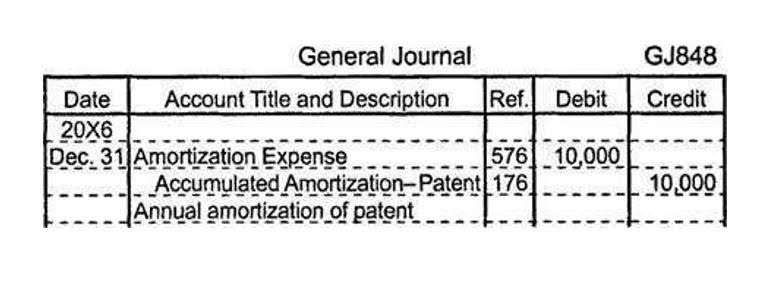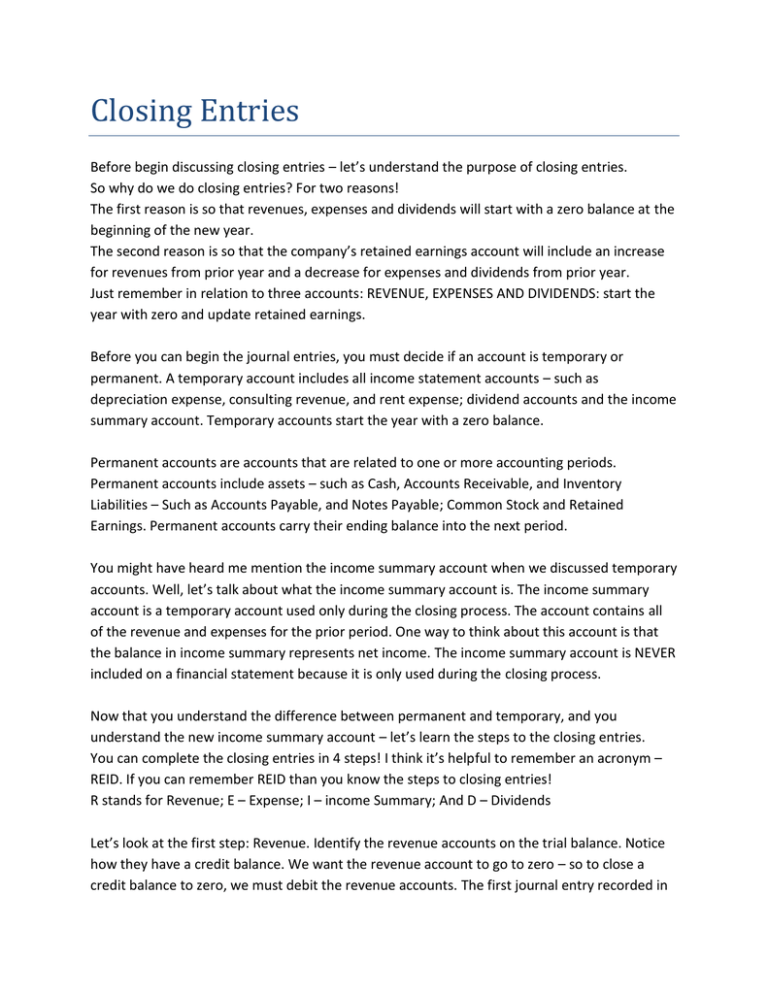
It can also create errors and financial mistakes in both the current and upcoming financial reports, of the next accounting period. Closing entries, on the other hand, are entries that close temporary ledger accounts and transfer their balances to permanent accounts. Closing all temporary accounts to the income summary account leaves an audit trail for accountants to follow. The total of the income summary account after the all temporary accounts have been close should be equal to the net income for the period.
Step 4: Close withdrawals account
If dividends were not declared, closing entries would cease atthis point. If dividends are declared, to get a zero balance in theDividends account, the entry will show a credit to Dividends and adebit to Retained Earnings. As you will learn in Corporation Accounting, there are three components to thedeclaration and payment of dividends. The first part is the date ofdeclaration, which creates the obligation or liability to pay thedividend. The second part is the date of record that determines whoreceives the dividends, and the third part is the date of payment,which is the date that payments are made. Printing Plus has $100 ofdividends with a debit balance on the adjusted trial balance.
Which of these is most important for your financial advisor to have?
It involves shifting data from temporary accounts on the income statement to permanent accounts on the balance sheet. Your business will need to transfer the balances into the income summary account to close these revenue and expense accounts. The income summary account is another temporary account, only used at the end of an accounting period. This account helps businesses shift their revenue and expense balances from the temporary accounts into the permanent account known as retained earnings found on the balance sheet.
How much are you saving for retirement each month?
He has been the CFO or controller of both small and medium sized companies and has run small businesses of his own. He has been a manager and an auditor with Deloitte, a big 4 accountancy firm, and holds a degree from Loughborough University. Instead, as a form of distribution of a firm’s accumulated earnings, dividends are treated as a distribution of equity of the business. Shaun Conrad is a Certified Public Accountant and CPA exam expert with a passion for teaching. After almost a decade of experience in public accounting, he created MyAccountingCourse.com to help people learn accounting & finance, pass the CPA exam, and start their career.
The assumption is that all income from the company in one year is held for future use. One such expense that’s determined at the end of the year is dividends. The last closing entry reduces the amount retained by the amount paid out to investors. Temporary accounts are used to record accounting activity during a specific period. All revenue and expense accounts must end with a zero balance because they’re reported in defined periods. A hundred dollars in revenue this year doesn’t count as $100 in revenue for next year even if the company retained the funds for use in the next 12 months.

For the past 52 years, Harold Averkamp (CPA, MBA) hasworked as an accounting supervisor, manager, consultant, university instructor, and innovator in teaching accounting online. He is the sole author of all the materials on AccountingCoach.com. For the past 52 years, Harold Averkamp (CPA, MBA) has worked as an accounting supervisor, manager, consultant, university instructor, and innovator in teaching accounting online. An accounting year-end which is not the calendar year end is sometimes referred to as a fiscal year end.
Temporary accounts include all revenue and expense accounts, and also withdrawal accounts of owner/s in the case of sole proprietorships and partnerships (dividends for corporations). Opening entries, also known as initial entries, are made at the beginning of an accounting period. All opening entries should be recorded in the general ledger journal of the business and will represent how to increase your cen exam score the opening balance of accounts for the new period. Reporting cycles are an essential part of the accounting process. The cyclical reporting of accounting periods can span monthly, quarterly, and annual time frames. However, when it comes to opening and closing accounts, this typically happens on a yearly or monthly basis, depending on the type and size of the company.
- Now for this step, we need to get the balance of the Income Summary account.
- Permanent accounts, such as asset, liability, and equity accounts, remain unaffected by closing entries.
- The total debit to income summary should match total expenses from the income statement.
- This means that thecurrent balance of these accounts is zero, because they were closedon December 31, 2018, to complete the annual accounting period.
- Essentially, all opening entries of a new fiscal year are the exact entries and figures of the previous period’s closing entries.
- The purpose of closing entries is to prepare the temporary accounts for the next accounting period.
Temporary accounts can be found in the accounting ledger, specifically the general ledger of accounts. This ledger is used to record all transactions over the specific accounting period in question. This list of general ledger accounts with their balances is known as the trial balance. On the statement of retained earnings, we reported the ending balance of retained earnings to be $15,190. We need to do the closing entries to make them match and zero out the temporary accounts. After the closing journal entry, the balance on the dividend account is zero, and the retained earnings account has been reduced by 200.
These journal entries are made after the financial statements have been prepared at the end of the accounting year. A closing entry also transfers the owner’s drawing account (a temporary balance sheet account) balance to the owner’s capital account. The closing entries will mean that the temporary accounts (income statement accounts and drawing account) will start the new accounting year with zero balances. A closing entry is a journal entry made at the end of an accounting period.
The closing entries are also recorded so that the company’s retained earnings account shows any actual increase in revenues from the prior year and also shows any decreases from dividend payments and expenses. Journal entries are an essential part of the accounting process for any business. Whether your company uses single or double-entry accounting, you will need to ensure the proper method of opening and closing journal entries happens at the designated time.
Closing entries are an important facet of keeping your business’s books and records in order. By maintaining your bookkeeping, you can ensure that you are constantly kept informed. As well as being consistently up-to-date on the financial health of your business. LiveCube Task Automation is designed to automate repetitive tasks, improve efficiency, and facilitate real-time collaboration across teams.

